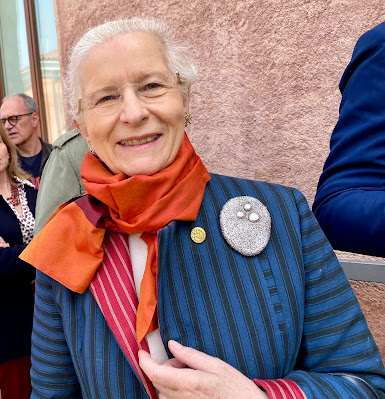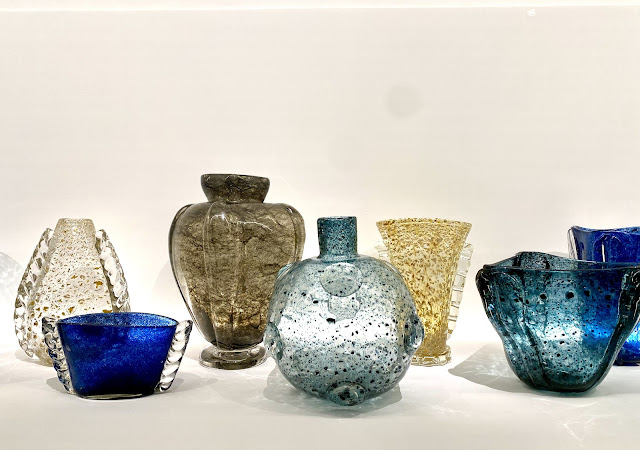"This was a period of great creativity and experimentation with materials and colours, both through the revisiting of ancient techniques and the development
of new glassmaking processes".
Le Stanze Del Vetro
1932-1942 Murano Glass and The Venice Biennale
Exhibition - Party Photos
At Le Stanze Del Vetro on the Island of San Giorgio Maggiore the exhibition 1932–1942 Murano Glass and the Venice Biennale - curated by Marino Barovier - until - 23 November - is the second chapter in the series on Murano glass at the Venice Biennale. It explores the decade from 1932 to 1942, spanning the 18th to the 23rd editions—from the opening of the Venice Pavilion to the final pre-war Biennale.
Ferro Tosso-Barovier - Ercole Barovier - 1938
Since 1932, Murano glass was featured at the Biennale in a dedicated space, the Venice Pavilion - above - built specifically for the decorative arts on the initiative of the - Istituto Veneto per il Lavoro. The value and quality of the so-called minor arts were thus officially recognized, and a selection of them were chosen to be presented to the general public at the Venice Art Biennale. Thanks to the recurrent staging of this prestigious event, such exhibits had a profound effect on Murano, which over the course of successive editions took the opportunity to present its best glass works, making the most of the impetus provided by the Biennale. The Venice Biennale not only served as an outstanding showcase, but through its artistic vibrancy and international reach it provided fruitful exposure to glassworks and the world of artistic glass in all its complexity.
Curator - Marino Barovier
Salviati & C. - Guido Bin - Mario De Luigi - 1936
Salviati & C. played a key role at the Venice Biennale - 18th–20th editions - showcasing innovative glassworks. Of particular note were the vetri musivi by Guido Bin - Mario De Luigi - in 1936 - bold mosaic-inspired pieces that reflected his deep interest in glass and collaboration with Carlo Scarpa. Salviati’s displays consistently highlighted artistic experimentation, blending classical forms with modern expression.
Giorgio Spanu and Nancy Olnick
Venini S.A. - Tomaso Buzzi - 1932
At the 1932 Venice Biennale, Venini S.A. presented La Mano di Atlante, a striking mosaic panel by Tommaso Buzzi, marking his brief but impactful collaboration with the firm. Buzzi also introduced the Turchese e nero series - above - elegant, layered glass pieces inspired by ancient Persian forms—showcasing Venini’s refined color and form experimentation.
At the Venice Biennale, Zecchin-Martinuzzi showcased groundbreaking cased glass works that highlighted their technical mastery and artistic vision. Founded in 1932 by Vittorio Zecchin and Napoleone Martinuzzi, the firm quickly gained recognition for its thick-walled, color-layered glass pieces. Their Biennale displays featured elegant forms - vases, bowls, and sculptural objects - celebrated for their rich tonal contrasts and classical inspirations. Martinuzzi’s innovative use of cased glass set a new standard in Venetian glassmaking. The duo’s work bridged tradition and modernity, merging ancient influences with bold, contemporary forms
Zecchin Martinuzzi - Napoleone Martinuzzi
Corallo pasta vitrea vases -1933
In 1932, Zecchin and Martinuzzi founded their own glassworks, Zecchin Martinuzzi – Vetri Artistici e Mosaici. Martinuzzi focused on cased glass and colorful pasta vitrea. The firm also debuted successfully at the 5th Milan Triennale in 1933, showcasing vibrant figurines in pasta vitrea.
Susanne Thun Hohenstein
V.A.M.S.A. - 1938-40 + V.A.M.S.A. - 1940
Between 1938 and 1942 - V.A.M.S.A. - under Alfredo Barbini’s skill and the artistic direction of Erme Ripa and Luigi Scarpa Croce, the glassworks produced bold, heavy pieces. Highlights included sommerso plates with animal motifs -fumato glass animals - and hot-modeled figures adorning thick bowls shown at the Venice Biennale in 1942.
Giordana Naccari and Giuseppe Baldissera
In 1937 Seguso Vetri d’Arte, with Flavio Poli as partner and artistic director - showcased - at the the Venice Biennale - bullicante vases - with fine air bubbles a technique devised by Archimede Seguso - heavy glass animals, and thick forms in verde nord and verde acqua di mare, some with corroded finishes and soft, sculptural lines.
Herwig Egon and Elena Casadoro-Kopp with Oskar
Antonio and Anna Dei Rossi
From 1940, Dino Martens became artistic director at Aureliano Toso, leading the 22nd Venice Biennale display. The showcase featured heavy cristallo glass with spiral ribbing and soft color accents, alongside zanfirico cane pieces in similarly delicate tones.
photo Enrico Fiorese - courtesy le Stanze del Vetro - Installation View
Installation View - detail
Ferro Toso-Barovier
The Ferro Toso-Barovier glassworks debuted at the 1936 Venice Biennale under the artistic direction of Ercole Barovier. At this exhibition, they showcased large, innovative glass pieces using colorazione a caldo senza fusione - a technique Barovier developed and patented. Notable works included the Crepuscolo series, made with brownish-grey glass and metal filaments, and Gemmati, which featured glass with metallic oxides and powders in variations like Autunno - yellow-brown -Laguna, and Marina - blue-grey. This led to the creation of new types such as Zaffiro and Arabesco Verde. The Rostrati series, with its raised glass prisms, became particularly commercially successful.
At the
1942 Venice Biennale, the Venini display primarily featured blown-glass pieces decorated with threads,
horizontal bands, or irregular polychrome patterns - pennellate - standing out from the
transparent surface. It also included transparent bowls with deliberately irregular forms
featuring abstract black and blue - zaffiro - black motifs influenced by Bauhaus art.
Salviati & C. - Dino Martens - 1932 + 1932ca.
At the 1932 Venice Biennale, the Salviati display featured a selection of transparent glass pieces – vases, ‘amphorae’, pitchers, and oil jugs – designed by Dino Martens - whose classical forms had been reinterpreted with a playful touch.
Isola di San Giorgio – Monumental Complex
Fondazione Giorgio Cini
Palladian courtyard of the ex Benedictine Monastery
Lunch was served al fresco in one of the two Palladian courtyards
Giovanni Rubin de Cervin Albrizzi
Verdiana Durand de la Penne
from
Isola di San Giorgio Maggiore










































